On my “Light Over Heat” YouTube channel this week, I discuss sociologist Harel Shapira’s opinion essay, “Firearms Taught Me, and America, a Very Dangerous Lesson,” published in the New York Times on 16 May 2023 (gift link here should take you behind the NYT paywall if you haven’t seen the opinion yet).
The title, of course, is provocative and the essay certainly provoked considerable attention on my social media feeds. My gun-skeptic friends had all of their biases about Gun Culture 2.0 confirmed, while my gun-sympathetic friends didn’t recognize themselves in Shapira’s characterization.
As usual, I tried to translate between these two different perspectives, but 140 characters doesn’t allow for much nuance.
So, in addition to 11 minutes of more free-flowing “Light Over Heat” video comments, this blog post presents the points I would like to make more systematically.
TL:DR I have learned very different lessons from firearms classes than Harel Shapira.
[1] I know Harel Shapira
First, I know Harel Shapira personally. In fact, I invited him to present an early version of his research on defensive gun training to my Sociology of Guns course and to the Wake Forest University community back in 2016. His concept of “civilized violence” doesn’t appear in his NYT essay, but it is insightful and I imagine it will appear in his book-length treatment of this, Basic Pistol: Living and Dying by the Gun in America (forthcoming, 2024).
Our paths have since crossed several times, both IRL and in print. I published my analysis of “The Rise of Self-Defense in Gun Advertising: The American Rifleman, 1918-2017″ in a book Shapira co-edited with Jennifer Carlson and Kristen Goss; he published an article on “How Attitudes about Guns Develop over Time” in a professional journal I co-edited with Trent Steidley; and our work has appeared alongside each other in another book, The Lives of Guns.
[2] Shapira is not dishonest
Therefore, I do not think that Shapira is lying or being disingenuous in his NYT essay. I think he is accurately reporting what he saw in his research.
[3] Empirical Limitations
Of course, what he saw is limited by his own data. He notes in the essay that he observed 42 classes and interviewed 52 instructors and 118 students in at least four states (Texas, Massachusetts, New Jersey, and Illinois) but “immersed” himself in firearms schools in Texas, where he teaches at the University of Texas in Austin.
This is actually considerably more research than went into other books on defensive gun culture like Jennifer Carlson’s pathbreaking Citizen-Protectors: The Everyday Politics of Guns in an Age of Decline or Angela Stroud’s Good Guys with Guns: The Appeal and Consequences of Concealed Carry (2016).
Having done qualitative research my entire career, I can attest to how much time and effort goes into this doing much observation.
I can also attest to the humility that doing empirically limited qualitative and interpretive social research should bring. Such humility was not on display in Shapira’s opinion essay. Of course, the New York Times would not publish it in that case.
[4] Subjective Limitations
Beyond the empirics, what he saw is also shaped by his personal/cultural orientation to guns and the intellectual frameworks he brought to/developed in his research.
This is not a condemnation of Shapira, but a simple recognition of how social science (and, some would argue, natural science) actually works. As I learned as an undergraduate at UC-Berkeley studying theory under the renowned Marxist sociologist Michael Burawoy, there is no perfect standpoint of objectivity in research (“Punctum Archimedis”).
“There is no well so deep that leaning over it one does not discover at bottom one’s own face.”
Philosopher Leszek Kolakowski
I actually went off on the New York Times editorial board over eight years ago and what I wrote then applies here as well.
But this does not mean that everything is completely relative and the quest of objectivity should be abandoned. To the contrary, it means we should redouble our efforts to recognize and distance ourselves from our biases. Personal efforts at critical reflection can help, and so can participating in a community of science as individuals with different personal starting points engage in dialogue that can surface their biases.
Of course, if everyone in a scientific community shares the same starting points, then the biases never get surfaced, as seems to happen among public health scholars studying guns and violence.
Incredibly, I wrote that before having read Jonathan Haidt’s The Righteous Mind in which he makes essentially this same point, that “good reasoning [is] an emergent property” of a “community of scientists” characterized by “intellectual and ideological diversity.”
[5] Therefore, Shapira’s Truth is Partial
So, I do not think Shapira is simply wrong in his observations about firearms classes. But his truth is partial, in both senses.
It is incomplete (point #3) and represents a particular perspective (point #4).
[6a] Differences in Observations
There’s nothing wrong with #5 per se. My own research and writing on guns are also partial. Whereas Shapira seems to have focused his attention on lower-level, local, basic gun training courses, I have spent most of my time studying high-level, national gun trainers and courses (though I do know there is at least one very advanced gun school we have in common).
This surely accounts for some of how we may see things differently. Many people I know in Gun Culture 2.0 are critical of poorly-qualified self-defense instructors and poorly taught self-defense courses. John Correia of Active Self Protection, for example.
And as I have written about in a series of posts on this blog (e.g., this one on “What is a ‘professional civilian firearms trainer’”), with the exception of concealed carry instructors in certain states (like North Carolina), “civilian firearms instructor” as an occupation is unregulated by any local, state, or federal agency. In such an environment, anyone can put up a shingle that says “I are a gun trainer,” to quote Ken Campbell, COO of Gunsite Academy, a nationally-recognized gun school I have observed.
So, the likelihood that Shapira observed low-quality but probably common forms of firearms instruction is high. By contrast, I have focused on what in 2018 I called “the frontiers of defensive gun culture,” like John Murphy’s Concealed Carry: Advanced Skills and Tactics course, Alliance Police Training’s Carbine Shoothouse course, Craig Douglas’s Extreme Close Quarters Concepts course, and The Complete Combatant’s Force Readiness course. (There are many others I have not yet had the opportunity to observe.)
I have additionally been exposed to some very deep thinkers on issues of personal defense, like John Correia (“Lessons Learned from Watching 20,000 Gunfights”), John Johnston (“The Work Never Ends”), Dr. Sherman House (“Becoming the Civilian Defender”), and Claude Werner (“Negative Outcomes, Standards, and Gun Culture 3.0”), to name just a few.
My different take on the defensive firearms training (cottage) industry in comparison to Shapira’s can be found in the specific links scattered about this post as well as in my collected posts page on this blog.
[6b] Differences in Interpretation
However, beyond us studying different parts of the gun training industry, there seem to be differences even in how we interpret the same things. For example, Shapira asserts that the classes he observed “trained students to believe that their lives are in constant danger.” The classes I observed also addressed the issue of risk, but the focus was more on the ever-present possibility of danger but the low probability of danger.
As Shapira rightly observes, “It’s not the odds, I heard on numerous occasions; it’s the consequences.” The lesson Shapira learned from this is “that I ought to shoot even when my instincts might tell me otherwise.” In other words, shoot first and ask questions later.
As I have written on this blog, and at greater length in a chapter of my so-far spurned book, low odds/high stakes is part of the gun culture version of Pascal’s Wager. While some people no doubt respond to Pascal’s Wager with religious fanaticism — shoot first and ask questions later — Pascal suggests a more cautious, reasoned approach.
I’ve seen cautious, reasoned approaches discussed incessantly in Gun Culture 2.0. Specifically, how practices of avoidance, awareness, and preparedness — the motto of gun educator Michael Bane’s TV show “The Best Defense” — can lower people’s risk of needing to shoot at all. As the cliche suggests, “The first rule of gunfighting is don’t be there,” or as gun writer Tam Keel puts it, “Can’t lose a fight you’re not in.” Follow gun trainer John Farnam’s “rules of stupid.” Heed trainer Craig Douglas’s admonition to “not let things get shitty” in the first place.
Of course, risk assessment is subject to all sorts of biases (h/t Daniel Kahneman), but Shapira sees his fellow students as worse risk analysts than I see in my wandering around gun culture. In this, he is working within what I have called The Standard Model of Explaining the Irrationality of Defensive Gun Ownership. Insofar as he focuses on hegemonic masculinity and whiteness, he contributes to the argument that something other than objective risk motivates defensive gun ownership.
But back to our different ways of interpreting the same data, using the color codes of personal awareness codified by Jeff Cooper, one of the founders of the civilian defensive gun training industry via Gunsite. Shapira interprets instructors as saying students should constantly be in code orange (specific alert, full attention) or even code red (mental trigger, fight or flight), while I saw instructors suggesting students avoid code white (unaware and unprepared) in public and to be in code yellow (relaxed awareness) instead.
Consider the following scene portrayed by Shapira:
Outside a restaurant in Austin, an instructor saw a disheveled man sitting on the curb and nudged me in the other direction, directing me to pick up the pace. He said he had detected “potential predatory behavior” and wasn’t sure if this man was a panhandler or someone about to stick a gun in our faces.
Harel Shapira, New York Times
For Shapira, this is the kind of avoidance that reflects people being trained “to be suspicious and atomized,” which in turn undermines “the kind of public interactions that make democracy viable.” For me, this is the kind of avoidance that reflects people being aware of their surroundings and taking simple, non-threatening, non-violent actions to protect themselves. It’s the kind of avoidance my sisters (who have never taken a firearms class) use when they walk around San Francisco. It’s the kind of avoidance that my mother (who has never taken a firearms class) uses when she doesn’t answer her front door for people she doesn’t know or is not expecting.
It’s not the only possible response to this situation (see the concluding section below), but it’s also not a democracy-corroding response.
Obviously, there’s more to Shapira’s argument than this particular incident or that specific class teaching. Big picture, Shapira correctly identifies the “primary lessons” of defensive firearms courses as being “if and when to shoot someone on purpose” (emphasis added). Intriguingly, Shapira suggests “this is where the trouble begins.”
Here I suspect, but cannot prove, that Shapira’s view reflects a common sentiment among liberals in the academy studying guns: That the very idea of shooting someone on purpose is offensive. For example, he writes, “Repeatedly the lesson was that I ought to shoot even when my instincts might tell me otherwise.”
Would Shapira’s instincts ever tell him he ought to shoot someone on purpose? Perhaps we will find out in his book.
As for me, my instincts tell me that I don’t ever want to shoot anyone on purpose. Going back to my childhood worship of Dr. Martin Luther King and his ethic of nonviolence, I feel that “violence is rarely the answer,” to quote Tim Larkin. But, he continues, “when it is, it’s the only answer.”
So, my instincts have definitely been shaped by involvement in Gun Culture 2.0, teaching me that violence can be virtuous and to distinguish between the black swan times when violence IS the answer and the normal times when violence IS NOT the answer. This is in contrast not just to Shapira’s sense of things, but to arguments that participation in defensive gun culture is harmful to one’s character.
At the risk of playing armchair psychologist to Shapira’s armchair psychology (to the extent that he is delving into the psychology of gun owners), Shapira’s own psychology may be playing an outsized role in his interpretations.
“Officially,” Shapira writes, “the message is caution.” I couldn’t agree more. But, he suggests, there is a hidden curriculum (my term not his) in gun schools that affects students far more than what is officially taught.
(Hidden curriculum is a concept emerging from the sociology of education that suggests “the implicit, unintended, and frequently unrecognized outcomes of schooling” can be even more influential on students than the formal curriculum. See an excellent application of the concept of “hidden curriculum” applied to campus rape prevention education by Martha McCaughey, who has also written an interesting treatment on the role of guns in relation to physical feminism. But I digress.)
Shapira argues that “relentlessly harping on the dangers that surround us changes the way students assess those risks” in troubling ways. How does he know?
“I experienced it myself.”
Case in point:
On a recent night I saw a driver who didn’t appear to realize that he was going the wrong way on a one-way street. As the other car approached, I began to slow down, roll down my window and stick my hand out in a friendly gesture. Suddenly I worried the other driver might have a gun. How might he respond to someone slowing down a car and waving at him in the middle of the night? Would he shoot? Probably not. But it’s not the odds, I remember telling myself; it’s the consequences.
Harel Shapira, New York Times
This places a great deal of interpretive weight on how Shapira himself understood the hidden curriculum of gun schools. From this (and surely other examples drawn from his research), he concludes: “That’s the great irony of firearms training: In learning how to use a gun for self-defense, something that seems like it might give you confidence and a sense of safety, people end up feeling more afraid than before.”
My initial response to reading this was to invoke (on Twitter – my bad) a humorous parable that circulates widely in Gun Culture 2.0: Grandmother gets pulled over by a cop. Tells cop she has a gun in the car. Cop asks what she’s so afraid of. Grandma responds, “Absolutely nothing.”
Although I thought this comment was funnier than gun violence prevention luminary Daniel Webster did (see above), there is truth underlying this quip: Scholars for years have struggled to establish a clear and consistent empirical connection between owning guns and being fearful. Over 9 years ago I wrote about a paper presented at the American Society of Criminology in 2013 that found fear of crime was higher among those who did NOT own a gun.
A more recent study using a broader dataset concluded:
people who own guns tend to report lower levels of phobias and victimization fears than people who do not own guns. This general pattern is observed across multiple indicators of fear (e.g., of animals, heights, zombies, and muggings), multiple outcome specifications (continuous and count), and with adjustments for age, gender, race/ethnicity, education, household income, marital status, the presence of children, religious identity, religiosity, religious attendance, political orientation, region of residence, and urban residence.
Benjamin Dowd-Arrow, Terrence Hill, and Amy Burdette, “Gun Ownership and Fear” (2019)
Of course, this does not systematically compare fear in relation to taking defensive gun training classes, but in my decade-plus of fieldwork on Gun Culture 2.0, I have not seen a systemic connection between these classes and excessive fear.
The lack of a systemic connection either between gun ownership/fear or gun training/fear may help explain why cases like the recent Kansas City porch and upstate New York driveway shootings grab our attention. It’s not their frequency but their rarity (human bites dog, not dog bites human). Of the millions of people who have taken thousands of training courses like Shapira observed — courses which allegedly “prepared [students] to shoot without hesitation and avoid legal consequences” — why are there so few bad shoots?
Considering Shapira’s psychological disposition in relation to his empirical conclusions, the study of “Gun Ownership and Fear” quoted above is potentially helpful. “[P]eople who own guns tend to report lower levels of phobias and victimization fears than people who do not own guns . . . across multiple indicators of fear.” One reason people do not own guns — and react negatively to their use (e.g., having to shoot someone on purpose) — is that they are afraid of guns, just as they are afraid of lots of things in the world (animals, heights, zombies).
This can be interpreted social psychologically, as Jonathan Haidt would, or socio-culturally, as scholars associated with the “cultural cognition” perspective like Dan Kahan would. From the cultural cognition perspective, our worldviews shape our sense of what risks are real and what their potential consequences are. Egalitarians and communitarians, as sociologists tend to be, rate the risk of guns to be high and so favor their control. These assessments are prior to facts, and trump them.
The missing empirical link in Shapira’s argument is especially crucial because of the dire consequences he sees following from firearms class-inspired fear.
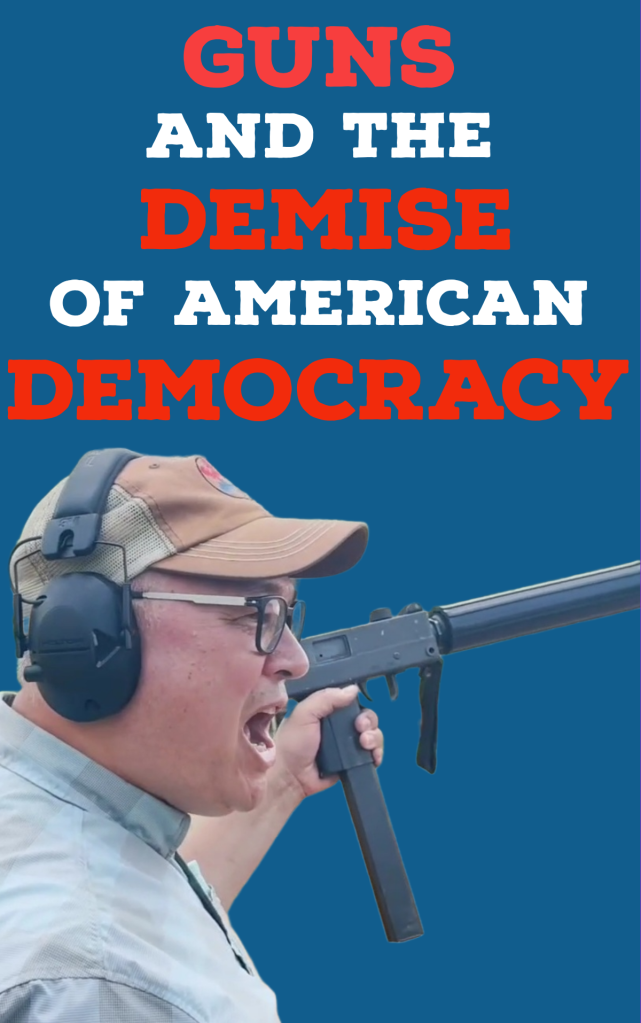
[7] The Guns Erode Democracy Master Narrative
As noted in point #4, when all of the partial empirical analyses of a topic come from the same partial perspective, you get a partial master narrative. Shapira’s particular narrative is that gun classes “instill the kind of fear that has a corrosive effect on all interactions — and beyond that, on the fabric of our democracy.”
This is a take on what I have just recently taken to calling the master narrative of democracy destroying right-wing gun politics. I see the narrative (more or less) in the work of Ryan Busse, Matthew Lacombe, Robert Spitzer, Patrick Blanchfield, Andrew McKevitt, and Jennifer Carlson — all of whom have recently published or will soon publish books on guns in America.
And this narrative sells. Big time. As reported in Publishers Marketplace, Pantheon acquired Shapira’s Basic Pistol: Living and Dying by the Gun in America in “a major deal.” This means an advance of more than $500,000 was paid for the book. This is a huge advance for an academic author and means the publisher thinks they can sell a shit-ton of Shapira’s book.
This contrasts sharply and, to be honest, painfully with my experience of 30+ publishers passing on the opportunity to publish my less inflammatory take on gun culture in America.
[8] A Different Mirror
But what if we look at guns, gun training, and gun culture through what the legendary UC-Berkeley historian Ron Takaki (and fellow Japanese-American FWIW) called “a different mirror”? Could this sort of diversity of ideas help us to understand these important phenomena better?
Because, in fact, firearms classes taught me very different lessons than Harel Shapira learned in his study.

From Brian Hill of The Complete Combatant and many others, I learned the value of having a diverse skill set — including pistolcraft, knife skills, martial arts, pepper spray, flashlights, phones, basic medical, and even the defensive value of “Run Fu.” These skills give people the power of choice, including the choice to fully and actively participate in social interactions in public. This, not coincidentally, is how those immersed in Gun Culture 2.0 that I have studied generally live their lives.
From Craig Douglas and others, I learned the power of “social literacy” in navigating public space. As we live our lives in society, we ought not scream at strangers to “get the fuck away!” or draw down on people just because they approach us. Sometimes people need help. They lose their kids or their way, they need medical help or a hand. Being aware of who is around us and being able to recognize pre-assault cues (that Douglas also teaches) can help us determine whether we want to engage an unknown contact and dictate the terms of that engagement in socially literate ways.
For me, the most important part of having social literacy is that it allows us not to treat public space as a battlefield to be negotiated but as a place to be enjoyed. As Douglas put it, “Sometimes you just want to go enjoy a museum without having to worry about whether you have a gun or not.”
After he taught in my Sociology of Guns class at Wake Forest, Douglas and I enjoyed dinner together at the Katharine Brasserie in the former R.J. Reynolds Tobacco headquarters, a beautiful old art deco building in downtown Winston-Salem. From there we walked to Bailey Park, an urban greenspace where I showed him the conversion of old Reynolds warehouses into a high-tech innovation district. We ended up meeting my wife Sandy at Fair Witness Fancy Drinks, a craft cocktail bar nearby. We shared a few drinks and a lot of laughs. And we didn’t have to yell at, eye gouge, punch, stab, or shoot anyone. It was a good day.
If you appreciate this or some of the other 250+ posts on this blog, please consider supporting my research and writing on American gun culture by liking and sharing my work.

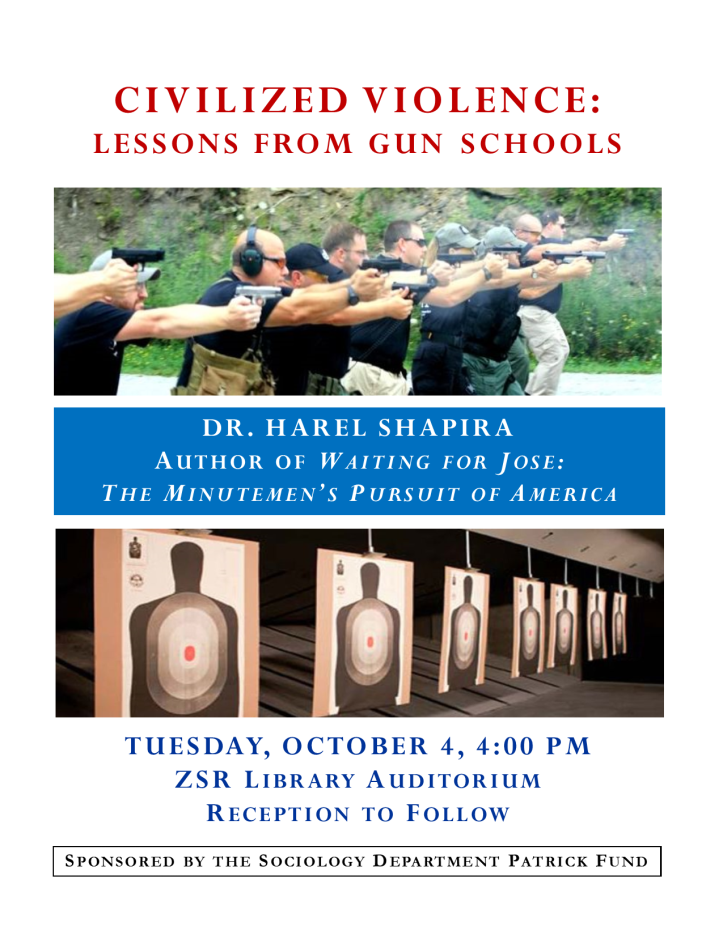
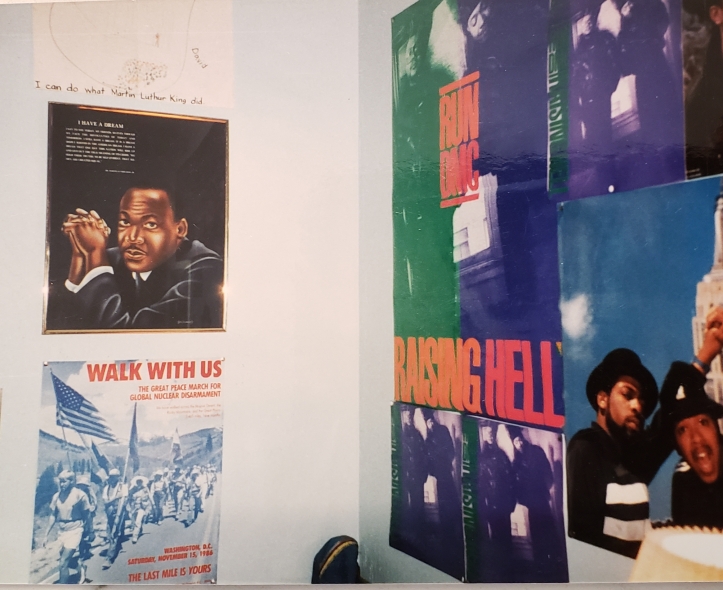
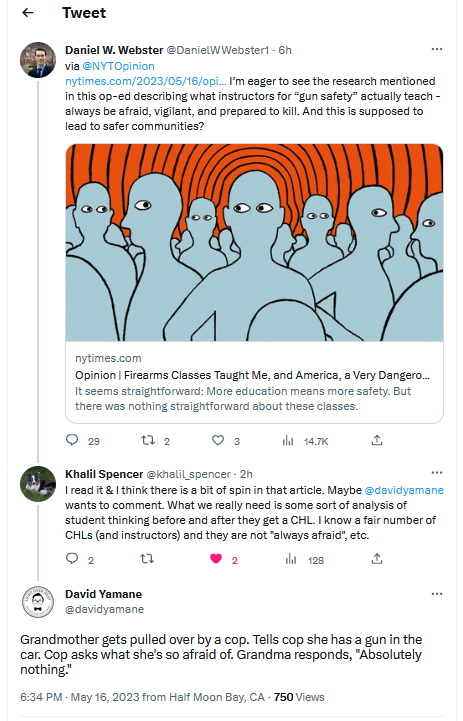
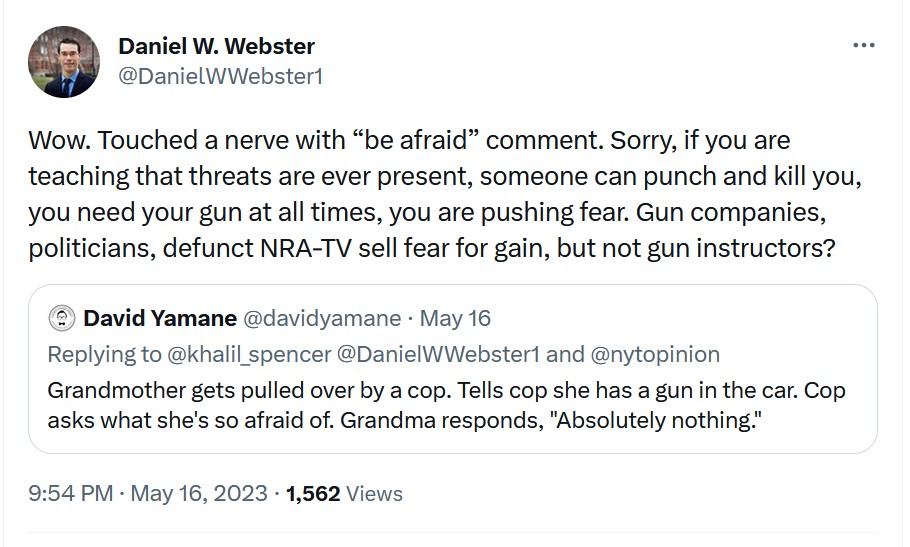

He stated: The classes I attended trained students to believe that their lives are in constant danger. They prepared us to shoot without hesitation and avoid legal consequences. They instilled the kind of fear that has a corrosive effect on all interactions — and beyond that, on the fabric of our democracy.
I have a hard time believing this as I also have taken classes, and yes the classes going into the legal aspects of shooting. This of course is necessary in many states which are hostile to gun owners, but also it is in general important to understand the limitations and resulting liability involved. I thought to myself after 43 classes you still have a fear, a deep rooted fear and I honestly think he should not have a gun except at a range. His fear will overwhelm him if he ever is in a situation which calls for the defensive use of a firearm and will not end well.
LikeLiked by 3 people
Great, comprehensive response. Really seeing the work here.
LikeLiked by 1 person
Also I have no doubt that some of the classes that Shapira attended were those low quality classes by “instructors” pushing fear and the wrong ideas, intentionally or not. They’re too common for him to have bucked the odds. Undoubtedly, these experiences stood out against the more sober, competent instruction elsewhere.
As always, screen your professors carefully, and make sure they actually know what they’re talking about.
LikeLike
> The lesson Shapira learned from this is “that I ought to shoot even when my instincts might tell me otherwise.” In other words, shoot first and ask questions later.<
The lesson he should have learned was, as his instincts are to never shoot no matter the circumstances, he is one of those people who should not own a gun. His is an atypical instinct, however — he might like to explore the cultural meme of 'mama bears' — so it should not serve as his yardstick for interpretation.
LikeLike
The idea that there are differences in quality between gun trainers should not be surprising. There are huge differences in quality among martial arts instructors who teach non-firearm related self-defense skills. For every Guro Dan Inosanto there are ten Joe Blows who have much less to teach, let alone some unrealistic sport techniques for the street. But that quality translates into concepts that are useful for all self defense approaches, armed and unarmed. In Jeet Kune Do Guro Dan and his graduated instructors would teach about basic distance management, proper defensive cover and stances, awareness of the actions of the opponent, the set up and the principle of interception one finds in JKD, Western Fencing and Filipino Martial Arts. Non-firearm related martial arts are useful in that they can be used in escalating “use-of-force” scenarios before going to deadly empty hand techniques, then weapons like batons, knives and firearms. But they also demonstrate the limitations of size, age and gender that firearms with proper training can offset in life-or-death scenarios. The well-balanced 30 year-old male martial artist can go empty-handed, or armed. The well-balanced 65 year old, 125 pound female martial artist is more likely going to want the technology of a weapon to offset her disadvantages against a 180 pound assailant. It is the street realities of self-defense that ideally should guide self defense courses. It’s also up to citizens to understand that some locales are more dangerous than others. At a Giffords Law Seminar at UCLA in October 2022, the Chief of Public Defenders of Cook County, Sharone Mitchell, spoke about the Bruen ruling. He noted that the vast majority of police traffic stops and searches happened in 16 “certain” neighborhoods in Chicago. If found with an un-permitted firearm the suspect faced 2 years of felony time if convicted. But he noted that many suspects were not otherwise lawbreakers, they were simply carrying for self-defense reasons just to make it to work and back. In all likelihood none of these people took formal firearms training courses when they could ill-afford the FOID process. Yet they had to be able to defend themselves from armed criminals who ignore Federal and State law. When teenage gangbangers carrying Glocks with illegal autoswitches can pop up and just start shooting, how unprepared and relaxed can people afford to be in the first place? The street is a very different kind of classroom than the halls of the nation’s colleges and universities. And for what it’s worth, gun culture is more concerned with those street realities than anything else.
LikeLiked by 1 person
I definitely tried to acknowledge that Shapira could have been studying some bad, lower-level instructors that shaped his take on firearms classes generally. That said, MANY people have told me since the read Shapira’s opinion some version of “I didn’t learn that in my concealed carry class” or “I didn’t learn that in my basic pistol class.” Now, maybe Shapira learned different lessons than these people. It’s possible that what was taught and what people who contacted me learned are different. But even in low level classes, I don’t think things are as egregious as Shapira depicted.
LikeLiked by 1 person